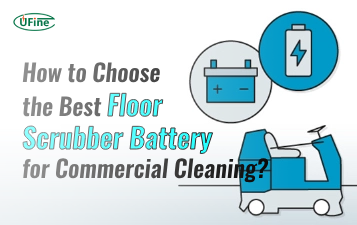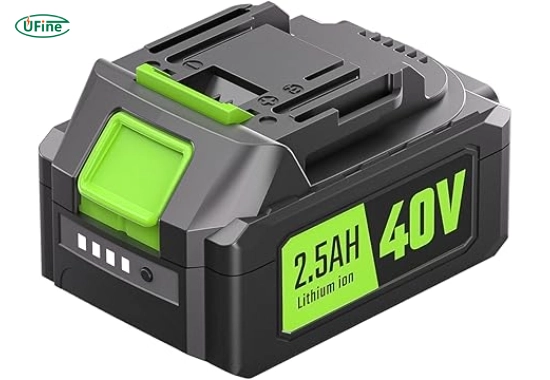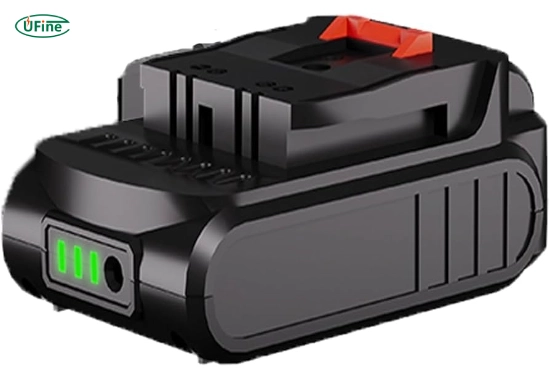Suppose you’re trying to buy the correct battery for a blower or a leaf vacuum. In that case, you’ve probably asked yourself, are they the same? Which one do I need?
The batteries for a blower and a leaf vacuum are often similar in design but differ in terms of power demand, runtime, and compatibility, depending on the tool’s intended purpose. Always match the battery to your tool’s brand, voltage, and usage requirements.
This comprehensive guide will help you understand the differences, what to look for, and how to choose the correct battery for your cordless outdoor tools. Whether clearing a backyard or vacuuming piles of autumn leaves, this guide ensures you pick the perfect power solution.
Part 1. What is a battery for a blower?
A battery for a blower is a rechargeable lithium-ion battery that powers a cordless leaf blower. These batteries deliver high bursts of energy, which are needed to generate strong air blasts that effectively move leaves, dust, or debris.
Key features of blower batteries:
- Voltage: Typically ranges from 18V to 80V
- Amp-hours (Ah): Determines how long the battery runs
- Watt-hours (Wh): Measures total energy (calculated as voltage × Ah)
Blowers demand quick bursts of power, especially when you’re trying to move wet or heavy leaves. That’s why they often require higher voltage batteries to perform well.
Part 2. What is a battery for a leaf vacuum?
A battery for leaf vacuum powers a cordless tool that sucks in leaves and debris instead of blowing them away. Like blowers, these tools use lithium-ion batteries. The batteries are often interchangeable across the same brand’s ecosystem.
However, leaf vacuums typically require:
- More consistent power draw for more extended periods
- Higher Ah ratings, mainly when used with mulching features
- Thermal stability, since vacuums can heat up faster during use
So, while the basic battery technology is the same, the workload profile differs.
Part 3. Are the batteries for the blower and leaf vacuum the same?
Not always. Even though both tools may use lithium-ion batteries, that doesn’t mean they are interchangeable.
Here’s what you need to check:
- Brand Compatibility: Most batteries are proprietary. A DeWalt battery won’t fit into a Ryobi tool.
- Voltage Match: A 40V battery won’t work in a 20V tool.
- Form Factor: Even if voltage matches, the physical design might not.
- Electronics: Smart batteries have internal chips that communicate with the tool. Mismatched tech can turn off functionality.
Some brands, such as Greenworks, EGO, and DeWalt, offer cross-tool compatibility, enabling you to use a single battery with multiple tools within the same voltage platform.
Part 4. How do you choose the right battery for the blower?
When choosing a battery for the blower, you need to match power output with your workload. Here’s how:
- voltage
Light-duty tasks: 18V–20V
Medium-duty (small yards): 40V
Heavy-duty (wet leaves, large areas): 60V or 80V - Amp-Hours (Ah)
2.0Ah: About 12–15 minutes of runtime
4.0Ah: 25–30 minutes
5.0Ah or more: 45+ minutes - weight
Higher-capacity batteries are heavier. A 5.0Ah 60V battery can weigh over 1.4 kg (3 pounds). That’s important for handheld tools. - Charge Time
Fast chargers can bring a 5.0Ah battery to full in under 60 minutes, but some standard chargers take 2–3 hours. Choose based on your usage frequency.
Part 5. How do you choose the correct battery for a leaf vacuum?
A leaf vacuum often runs longer than a blower and may also mulch leaves, which increases power needs. Here’s what to consider:
- Runtime (Ah)
4.0Ah minimum is recommended
6.0Ah or higher if you’re vacuuming large piles or mulching - Continuous Output
Look for a battery that delivers steady voltage, especially if your vacuum has multiple speed settings or a mulching blade. - Heat Resistance
Vacuums can heat up during extended use. Select batteries equipped with thermal management systems to prevent overheating.
Part 6. Can you use the same battery for the blower and vacuum?
Yes, if the tools are from the same platform. For example:
- DeWalt 20V MAX batteries are compatible with a wide range of 20V tools, including blowers, vacuums, drills, and more.
- EGO Power+ 56V batteries are compatible with all their 56V tools.
- Greenworks 40V line offers cross-compatibility between blowers, vacuums, mowers, and trimmers.
No, if the tools are from different brands or voltage platforms. Mixing voltage or brand-specific connectors will not work and may damage the tool.
Part 7. Battery specs to look for in both tools (with real data)
Here’s a comparison of actual battery specs used in popular blower and vacuum models:
| Brand | Voltage | Capacity (Ah) | Runtime (min) | Charge Time | Weight (lbs) |
|---|---|---|---|---|---|
| DeWalt 20V MAX 5.0Ah | 20V | 5.0Ah | 35–45 mins | ~90 mins | 1.4 lbs |
| EGO 56V 5.0Ah | 56V | 5.0Ah | 60–75 mins | ~50 mins | 4.0 lbs |
| Greenworks 40V 4.0Ah | 40V | 4.0Ah | 30–40 mins | ~60 mins | 3.0 lbs |
| Ryobi 40V 6.0Ah | 40V | 6.0Ah | Up to 60 mins | ~90 mins | 3.7 lbs |
| Makita 36V (2x18V) 5.0Ah | 36V | 5.0Ah | 40–50 mins | ~45 mins | 3.8 lbs |
Keep in mind:
- Watt-hours (Wh) = Voltage × Ah
- A higher Wh battery delivers more energy but also weighs more
- Choose based on your tool’s requirements and your comfort with handling heavier batteries.
Part 8. Pros and cons of using one battery for multiple tools
- Pros
Cost-Effective: A single battery can power multiple tools.
Convenience: Swap batteries quickly without waiting for a recharge.
Storage Efficiency: Fewer batteries mean less clutter. - Cons
Wear and Tear: A single battery used across multiple tools tends to wear out faster.
Power Mismatch: A 2.0Ah battery may be fine for a drill, but it’s too weak for a blower.
Downtime: If your only battery dies, all your tools are unusable.
Pro Tip: Consider buying two batteries for immediate use and one as a backup.
Part 9. Top battery brands for blowers and vacuums
Here are some of the best and most reliable battery brands on the market:
- DeWalt
Known for durability and fast charging
Wide compatibility in the 20V and 60V platforms
Great for both DIY and professional use - EGO Power+
The industry leader in 56V lithium-ion outdoor tools
Long battery life, quick charge times
High-end option for homeowners and landscapers - Greenworks
Offers 20V, 24V, 40V, and 80V options
Budget-friendly and eco-conscious
Great for average-sized yards - Ryobi
Excellent for homeowners on a budget
40V and 18V platforms are widely used
Batteries are easily available at Home Depot - Ufine Battery
Specializes in highly customized lithium-ion battery solutions
Offers OEM/ODM services for power tools, including blowers and vacuums
Ideal for brands or businesses seeking tailored battery packs with specific voltage, size, and performance needs
If you’re a tool manufacturer or run a business that needs custom-designed batteries, Ufine Battery is a top choice.
Part 10. Tips to extend battery life and performance
Want to get the most from your battery for a blower or vacuum? Follow these practical tips:
- Fully charge the battery before the first use
- Avoid deep discharges—recharge when it hits 20–30%
- Don’t store in extreme temperatures (ideal is 50–77°F or 10–25°C)
- Use a smart charger that prevents overcharging
- Keep contacts clean—wipe with a dry cloth regularly
- Store partially charged if not used for weeks (around 50%)
Proper care can double the lifespan of your lithium-ion battery.
Part 11. FAQs about batteries for blowers and vacuums
Can I use a battery from my blower in my vacuum?
Yes—if both are from the same brand and voltage platform. Otherwise, it won’t fit or function.
What is the ideal voltage for a battery in a blower?
For most users, 40V or 60V batteries strike the best balance between power and usability.
How long do batteries for leaf vacuums typically last on a single charge?
Most 4.0Ah to 6.0Ah batteries last between 30 and 60 minutes, depending on the suction power and tool efficiency.
Which battery brand is best for long-term use?
Brands like EGO Power+, DeWalt, and Ufine Battery are known for reliability and long lifespan.
Can I use a higher Ah battery on my tool?
Yes, as long as the voltage matches. Higher Ah means longer runtime but also more weight.
Related Tags:
More Articles

How to Choose the Best Floor Scrubber Battery for Commercial Cleaning?
Selecting the ideal floor scrubber battery ensures a long runtime, rapid charging, and minimal maintenance for efficient commercial cleaning operations.
How to Choose the Right Battery for Blower?
Choosing the right blower battery? Consider voltage, capacity, chemistry & usage. This guide helps match the best battery for peak performance.
How to Choose the Best Insulated Battery Box for Lithium Batteries?
Choosing the Best Insulated Battery Box for Lithium Batteries? Discover key factors such as size, material, and safety for optimal protection and performance.
7 Critical Elements on a Lithium Battery Shipping Label
What must be on a lithium battery shipping label? Learn 7 key elements to ensure safety, legal compliance, and correct handling across all transport modes.
UN3481 vs UN1323: Classification Guide for Lithium Batteries
UN3481 vs UN1323: UN3481 is for lithium batteries in equipment, while UN1323 covers flammable solids and doesn't apply to batteries.





